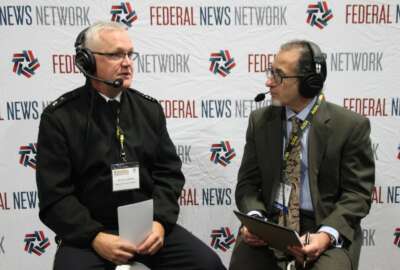

Rebecca Weirick, the executive director of the Services Acquisition Office of in the Deputy Assistant Secretary of the Army for Procurement, said category...
Best listening experience is on Chrome, Firefox or Safari. Subscribe to Federal Drive’s daily audio interviews on Apple Podcasts or PodcastOne.
Nearly every program office in the Army is under pressure to cut their budgets by 5% and move the money to modernization efforts.
The one area where that type of cut may come easiest is in the buying of common goods and services.
Rebecca Weirick, the executive director of the Services Acquisition Office of the Deputy Assistant Secretary of the Army for Procurement, said the Army already saved more than $1 billion through category management and those savings went to modernization and readiness priorities.

“We really have seen about a 9% savings from the actions we’ve taken,” Weirick said after her panel at the recent AUSA Acquisition Forum in Arlington, Virginia. “We believe category management will allow us to buy more with the same dollar.”
The Army’s success in 2019 bodes well as it has a goal of saving another 5% in 2020.
The Army’s foray into category management is part of the Defense Department’s broader effort to reform and consolidate back-office functions. The goal of category management is to understand how an organization is buying products and services and use the data to make better decisions around contract consolidation, price negotiations or the state of your industrial base.
The Air Force, for example, has been out in front of nearly every agency in government in changing its buying habits. The service has saved $1.5 billion, which is equal to 16% of the $9.8 billion in cost avoidance generated by the entire governmentwide category management program in 2018.
The most recent data from the Office of Management and Budget showed through category management agencies have eliminated more than 31,000 duplicative contracts and saved more than $25.8 billion through better pricing, reduced demand, and administrative savings.
OMB also says agencies more than accomplished the governmentwide goals for spend under management, using best in class designated contracts and for cumulative cost avoidance. The government, however, fell just short of the small business utilization goal of 30%.

Like the Air Force, the Army has been working toward these savings for several years with the efforts culminating in major savings in 2019.
Weirick said over the last few years the need to find money for modernization and readiness priorities helped pushed the use of category management to the top of the procurement agenda.
In 2018, for example, the Army published a directive that created category managers across six procurement areas, including professional services, facilities and construction and information technology.
In the memo, then-Secretary Mark Esper also directed that initial 5% savings along with a standard level of services.
Weirick said the Army went one step further under the IT category when it issued a memo in August severely limiting the buying of IT in the fiscal fourth quarter, which data shows cost 30 percent more than at other times during the year.
“We had a process where you could buy things, but if you did we wanted them bought smartly,” she said. “There was a strong reaction, like there always is when you are trying to change culture. The change management of that was we had been talking about this since April that we were going to do these standard levels of service. We saw we were paying more than we should’ve which as a taxpayer we all believe that’s our money we are spending so we don’t want to spend it in a way that doesn’t make sense. Ultimately, everybody embraced it.”
Weirick said the fact that the Army had a full budget on Oct. 1, 2019 contributed to the success of the category management initiative. She said folks were able to plan better and more smartly during the year instead of having a lot of pent up demand in the fourth quarter.
The Air Force took a similar tack in 2017 to get its spending on technology under control. The service brought together disparate data to consolidate and save money.
The Army is pushing further with category management by developing a new memo. Weirick said the policy is focused on changing the service’s culture rather than a more prescriptive type of memo.
“We will have some policies implemented that will drive change. Then there will be others that are more culture in nature,” she said.
Copyright © 2025 Federal News Network. All rights reserved. This website is not intended for users located within the European Economic Area.
Jason Miller is executive editor of Federal News Network and directs news coverage on the people, policy and programs of the federal government.
Follow @jmillerWFED


 Exclusive
Exclusive 
